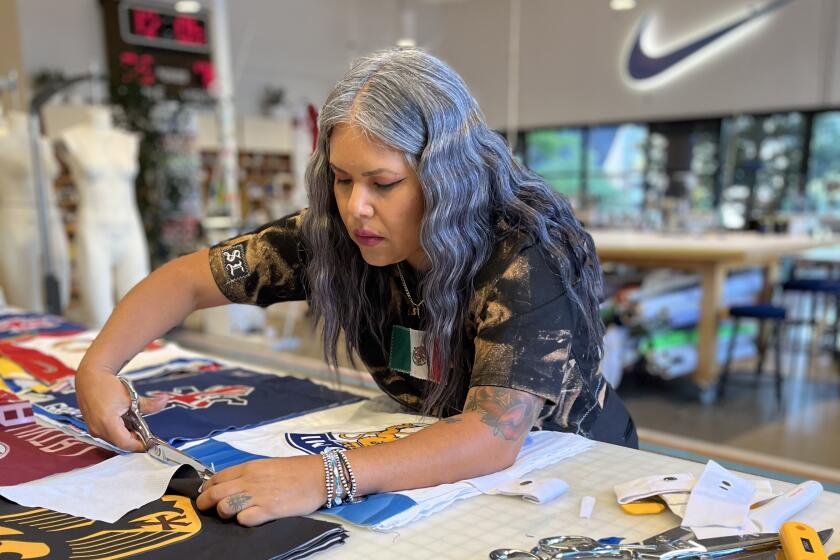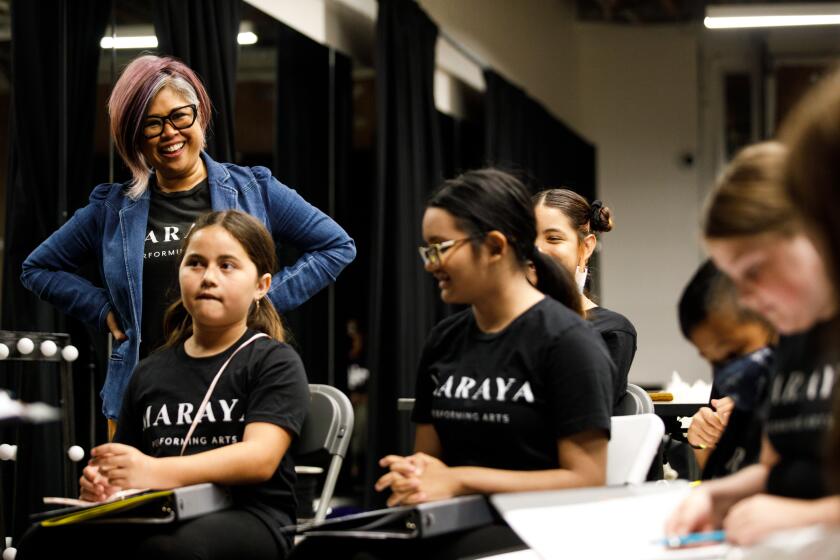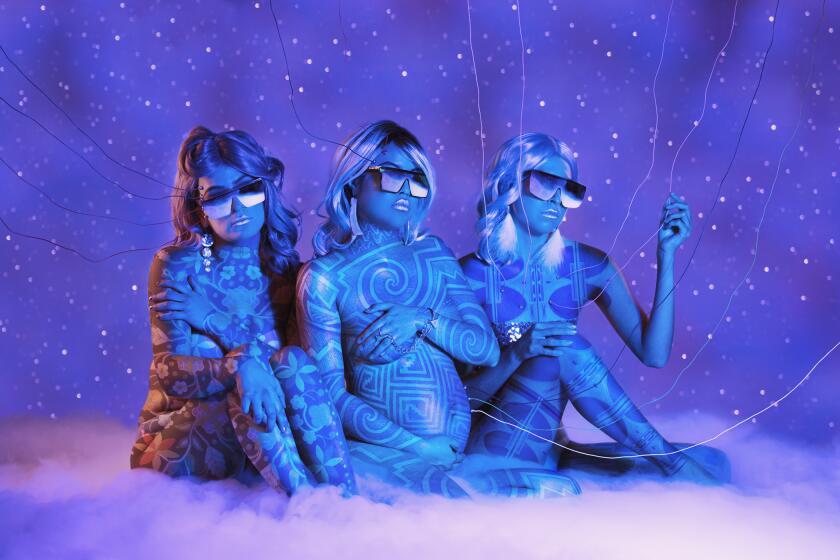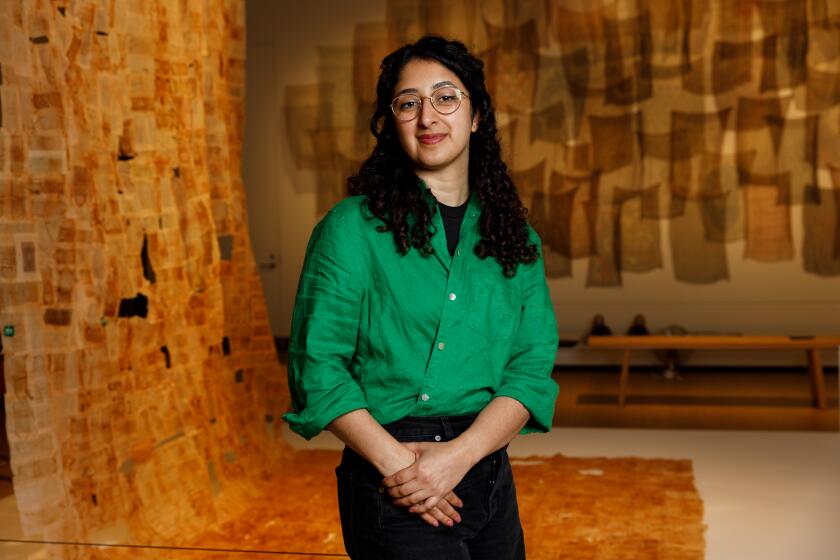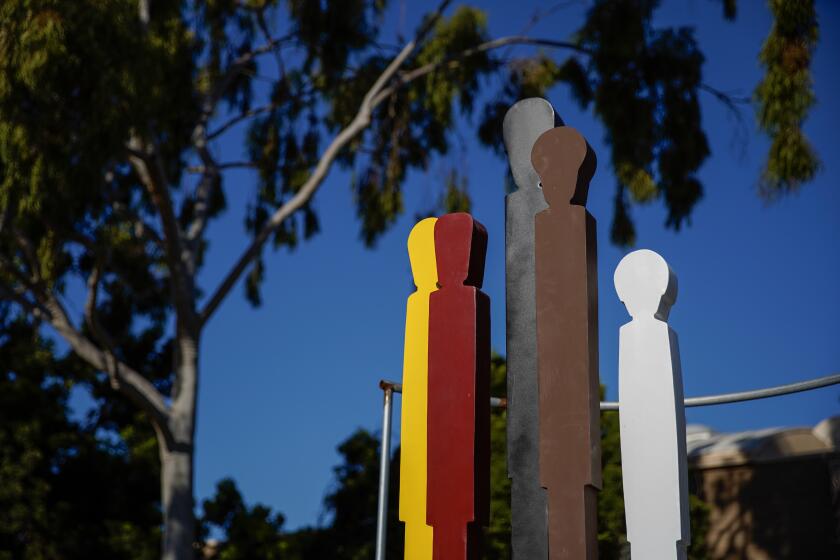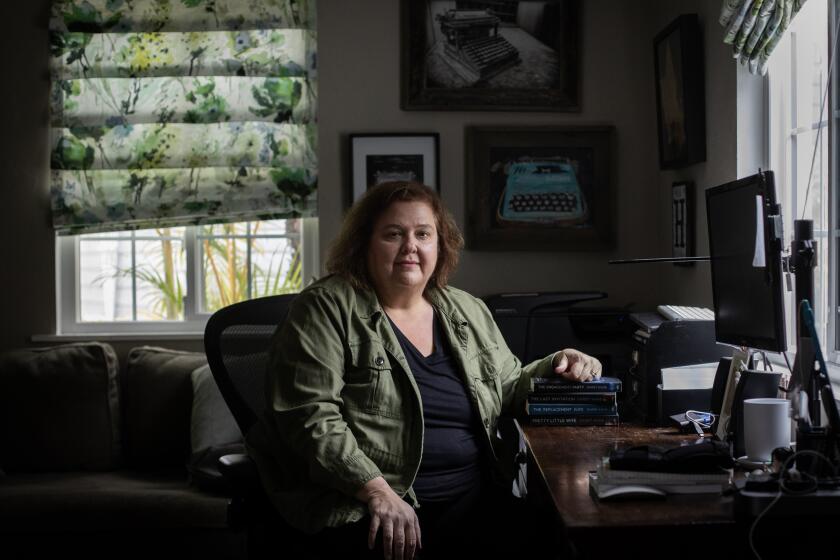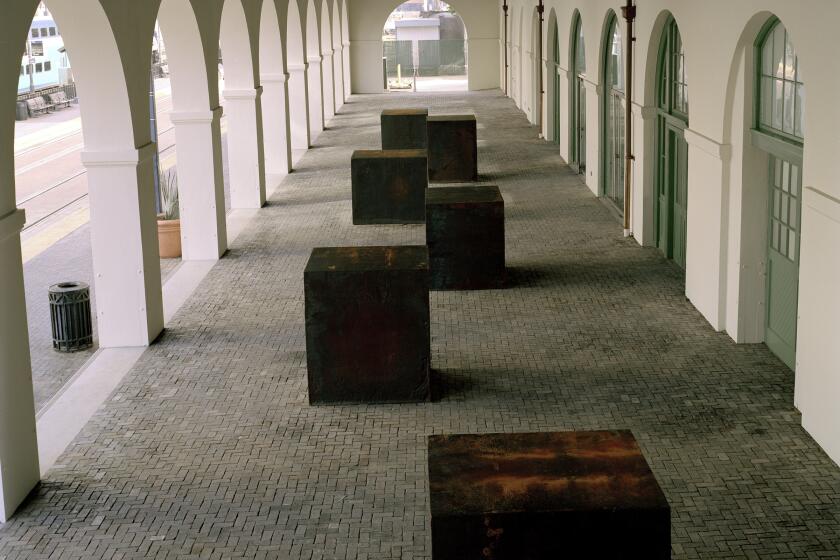San Diego Museum of Art captures the majesty of architect Louis Kahn’s work

Among the more than 200 objects in the exhibit “Louis Kahn: The Power of Architecture,” currently at the San Diego Museum of Art, is one that’s easy to miss — not only because of its placement but also because of what it is.
It’s a personal calendar, faded and old. It sits inside a glass case, a few feet from the entrance to the exhibit, dwarfed by a monumental wooden model of an uncompleted work by the late architect: City Tower, a building he hoped would be the seat of political power in Philadelphia, his home.
The calendar is opened to the month of October. The year: 1972. There, in Kahn’s rather ordinary handwriting in black ink or pencil, are daily appointments, some as mundane as lunch meetings. Upon closer inspection, one entry — that for Oct. 2 — speaks volumes about the man whose talent and skill forever changed architecture and, in many ways, the world.
Written in all capital letters: “FT. WORTH KIMBELL OPENING NIGHT”
It was a trivial entry, but its significance was hardly that. “Kimbell” was the Kimbell Art Museum in Fort Worth, Texas, considered one of Kahn’s most celebrated buildings and hailed by many as one of the most notable works of architecture of the 20th century. Opening night on Oct. 2, 1972, marked the end of a long journey that began in October 1966 when Kahn was chosen to design a building that founding director Richard Fargo Brown mandated be “a work of art” itself.
“Louis Kahn: The Power of Architecture”
When: Through Jan. 31.
Where: The San Diego Museum of Art, 1450 El Prado, Balboa Park.
Tickets: Free for members and children 17 and under; $8 for college students with full-time I.D.); $10 for military (active and retired with I.D.) and seniors (65 and older with I.D.); $15 for adults.
Phone: (619) 232-7931
Online: sdmart.org
Twenty photographs of the Salk Institute for Biological Studies, taken by students at Woodbury University School of Architecture, are displayed at The San Diego Museum of Art as part of the Louis Kahn exhibit.
October 1972 proved to be a momentous month for Kahn. Nineteen days later, on Oct. 21, another entry heralded the completion of yet another important body of work. “11 a.m. Dedication,” the entry says. “Exeter Library.” “Exeter Library,” in this case, is the Phillips Exeter Academy Library in Exeter, N.H. Today, it is considered one of the most important pieces of work in modern American architecture, highly regarded for its use of natural light.
“Louis Kahn: The Power of Architecture,” on view in 10,000 square feet of floor space at the San Diego Museum of Art through Jan. 31, is a sprawling assemblage of artifacts meant to honor the legacy of Kahn, whose work, as the museum describes it, “is regarded as a touchstone of 20th-century modernism.” Besides that personal calendar from the fall of 1972, there are models of works completed and uncompleted, pencil sketches, watercolor paintings, pastel drawings, photographs and film interviews of both Kahn himself and those whom he influenced, including Frank Gehry.
This exhibit — erected at the Balboa Park museum in the span of 11 days — has only been mounted at a handful of institutions around the globe. Last at the Bellevue Arts Museum in Washington — it was there from January through May of this year — it’s the most comprehensive retrospective of Kahn’s work since 1991. It is presented in collaboration with the Vitra Design Museum in Germany (where it was first exhibited), the New Institute in Netherlands and the Architectural Archives of the University of Pennsylvania, where many of the objects are from.
A different portrait of Kahn
“The exhibit was proposed to us some years ago,” said Ariel Plotek, curator of modern and contemporary art at The San Diego Museum of Art. “This is about one of the biggest projects that we have ever undertaken. It’s not something we do very much here, presenting exhibits about architecture. But there was obviously something about this one that brought it home.”
That “something” is the Salk Institute for Biological Studies in La Jolla. Designed by Kahn for Jonas Salk, the building was completed in 1965. Considered to be Kahn’s masterpiece, it was praised — and still is — for his reverential approach to architectural design, showcasing the symbiotic relationship between site and light and space. The Salk, with its orientation toward the breathtaking views of the Pacific, is stunning for its symmetrical design, featuring two sets of similar towers on each side of a plaza. In that plaza is a singular fountain that, twice a year during the autumnal and vernal equinoxes, aligns with the setting sun.
“There is in the Salk Institute,” Plotek said, “this sense of majesty and an austerity. Kahn’s work, here in La Jolla and elsewhere, harken back to the past with a strong connection to the present. In a sense, they remind you of the pyramids, the great buildings in Rome, but they’re here now for us to experience. I think Kahn’s architecture was, quite deliberately, backward looking. That’s one of the themes of the show. The influence of antiquity, whether Greek or Roman or Egyptian, even medieval. That kind of monumentality.”
The exhibit “is an opportunity to see the lesser known parts of Kahn’s oeuvre and process,” Plotek said. “Because his story has only been told once, this gives us a chance to present a different portrait of Kahn.”
Indeed, each mounting of this retrospective is different from the other. Many artifacts rotate, mainly because of their sensitivity to light. A handful of objects in this San Diego exhibit were not part of previous exhibits.
“It’s the first show focused on Kahn in a quarter century. He is a figure whose reputation and legacy has only grown in those intervening decades,” said Plotek, who first saw the Salk in person many years ago on a field trip when he was a graduate student at New York University’s Institute of Fine Art.
“One thing that people don’t realize is that he wasn’t as much an architect as he was a philosopher,” Plotek said of the architect, who died penniless in 1974 at the age of 73. “He had grand ambitions for architecture, but what he achieved with his work and approach is monumental. He combined design with technical innovation. We think of large architectural works being a matter of compromise and expediency, but Kahn belonged to a generation who created their buildings with ideas based on its function. That detailed and rigorous approach is inspirational — the belief that there is a transcendent quality to architecture.”
Louis Kahn’s work: Highlights
Yale University Art Gallery: 1111 Chapel St., New Haven, Conn. (begun in 1951, completed in 1953)
Richards Medical Research Laboratories, University of Pennsylvania: 3700 Hamilton Walk, Philadelphia (begun in 1957, completed in 1962)
Salk Institute for Biological Studies: 10010 N. Torrey Pines Road, La Jolla (begun in 1959, completed in 1965)
Jatiyo Sangshad Bhaban, the National Assembly Building of Bangladesh: Dhaka, Bangladesh (begun in 1962, completed in 1982)
Phillips Exeter Academy Library: Front Street, Exeter, N.H. (begun in 1965, completed in 1972)
Kimbell Art Museum: 3333 Camp Bowie Blvd., Fort Worth, Texas (begun in 1966, completed in 1972)
Franklin D. Roosevelt Four Freedoms Park: Roosevelt Island, New York City (designed in 1974, completed in 2012)
Special events
Cultures & Cocktails: 6 to 10 p.m. Nov. 17. $25 nonmembers, $5 members; $35 at the door. This is a 21 and up event. IDs will be checked at the door.
Friday Morning Lecture & Tour Series: Words and Works of Louis Kahn: Speaker: Len Zegarski, program chair, undergraduate architecture, NewSchool of Architecture and Design, San Diego. 10 a.m. lecture, 11:30 a.m. tour Nov. 18. $16 nonmembers; $13 members; $8 seniors and military; $5 students.
Architectural Photography Workshops: 10 a.m. to 2 p.m. Nov. 19 and Dec. 10. Museum Boardroom. $40 nonmembers; $30 members; $35 seniors and military. Same program presented both days.
Art of Élan: Defining Place: This concert focuses on place and origins and the links between the architecture and music. 7 p.m. Nov. 22. Gallery 16. $50 nonmembers; $40 members; $45 students, seniors and military.
Film: “Cathedrals of Culture: The Salk Institute”: Prior to the screening, Dr. Tom Albright of the Salk Institute will speak about the connection between architecture and neuroscience. 8 p.m. Dec. 9. $10 nonmembers; $5 members and students; $7.50 seniors and military.
Film: “My Architect: A Son’s Journey”: Filmmaker and son of Louis Kahn, Nathaniel Kahn, will introduce the film and participate in a Q&A session following the screening. 8 p.m. Jan. 13, 2017. $10 nonmembers; $5 members and students; $7.50 seniors and military.
Twitter: @outdoorlivingsd
Get U-T Arts & Culture on Thursdays
A San Diego insider’s look at what talented artists are bringing to the stage, screen, galleries and more.
You may occasionally receive promotional content from the San Diego Union-Tribune.




